Content
Most often in flower beds you can find classic tubular daffodils, which are the most popular inhabitants of spring flower beds. But besides them, there are many other different varieties.
We have made a selection of the most beautiful varieties of daffodils, whose amazing flowers will adorn any garden plot.
Crackington
A variety of double daffodils with very bright and catchy flowers. Crackington daffodils have a rich yellow color with an equally striking orange center. Of all the varieties of the terry group, this variety is considered one of the earliest (blooms in April). Flowers with strong peduncles, which allows them to be grown in any corner of the garden. The plant gives an excellent cut.
|
Appointment |
Group |
Stem height |
Bloom |
|
Terry |
45-60 cm |
Early April - mid april |
|
Ice King
Terry variety of daffodils with amazing flowering. The flowers are luxurious and large (can reach a diameter of 13 cm), creamy white and bright yellow shades. By the end of spring, they become creamy. The buds feature a corrugated crown. The first flowers appear at the end of April and last for 2-3 weeks. The Ice King variety is suitable for creating exquisite spring beds and flower beds, as well as for decorating borders.
|
Appointment |
Group |
Stem height |
Bloom |
|
Terry |
35-45 cm |
End of April - beginning of May |
|
Mount Hood
This variety of tubular daffodils blooms in April-May. The flowers are snow-white, very large - up to 13 cm, held on strong peduncles. The color of one bud can vary from creamy white to ivory. The color intensity of daffodils depends on the weather conditions: the warmer the spring, the richer the color will be.
The variety is especially appreciated for its delicate color and light aroma. Mount Hood daffodils bloom early and are suitable for planting anywhere in the garden: in a flower bed, on an alpine slide, in a curb, on a rabat, between bushes. Suitable for cutting.
|
Appointment |
Group |
Stem height |
Bloom |
|
Tubular |
40-50 cm |
End of April - beginning of May |
|
Pink Champagne
The variety belongs to the group of double daffodils with crown flowers. In one flower, you can observe a mixture of white and bright pink shades. The multi-colored petals are randomly arranged, which gives Pink Champagne a special elegance. These daffodils bloom in early May, suitable for growing in a flower garden or along a path.
|
Appointment |
Group |
Stem height |
Bloom |
|
Terry |
35-40 cm |
Early may |
|
Precocious
A tall variety of large-crowned daffodils with a massive bud with a large perianth. A distinctive feature of these daffodils is an openwork pinkish crown. The edges are of a darker shade, very strongly corrugated. The plant blooms in May and is great for landscaping the garden, as well as decorating the house with cut bouquets.
|
Appointment |
Group |
Stem height |
Bloom |
|
Large-crowned |
40-45 cm |
Mid may |
|
Rosy Cloud (Rosy Cloud)
The Rosy Cloud variety of double daffodils of white-pink color is considered the most unique of all existing ones, because they combine coloration and terry that are atypical for these plants. The openwork crown of flowers of this variety is corrugated much stronger than that of all other varieties. In addition, the color of the flowers can change (its saturation depends on the weather conditions). These daffodils look great anywhere in the garden and are also great for cutting.
|
Appointment |
Group |
Stem height |
Bloom |
|
Terry |
30-50 cm |
End of April - beginning of May |
|
Spellbinder
A mid-early variety of tubular daffodils.Blooms in late April - early May. The flowers are lemon yellow, lighter at the center, 10 cm in diameter. The peculiarity of this variety of daffodils is that their funnel-shaped tube changes color from yellow to white for a couple of days.
|
Appointment |
Group |
Stem height |
Bloom |
|
Tubular |
35-45 cm |
End of April - beginning of May |
|
Taurus
An unusual variety of large-crowned daffodils, which with its flowers at the same time resembles a lily and a carnation. The diameter of the flower is 10-12 cm, the height of the peduncle is up to 50 cm. The tall large crown (lemon-yellow at the base and delicate apricot at the edges) looks spectacular against the background of white petals. The variety is suitable for cutting, as it has tall and strong flower stalks. In the garden, daffodils of this variety look good in group plantings. They can also be planted along the paths.
|
Appointment |
Group |
Stem height |
Bloom |
|
Large-crowned |
30-50 cm |
End of April - beginning of May |
|
Thalia (Waist)
An early variety of tubular daffodils, which can delight with flowers as early as March. Flowering is intense and quite long for daffodils. Small white flowers contrast harmoniously with dark green narrow foliage. Due to its low height and neat shape, the variety is suitable for planting in the foreground of a flower garden or alpine slide, as well as for home distillation.
|
Appointment |
Group |
Stem height |
Bloom |
|
Triandrus |
30-40 cm |
End of March - beginning of April |
|
***
Daffodils have long adapted to the changeable climate of the middle zone, therefore they are considered quite traditional plants for a classic garden. However, if you competently approach the choice of varieties, you can grow such specimens that will surprise even the most sophisticated flower growers with their beauty.
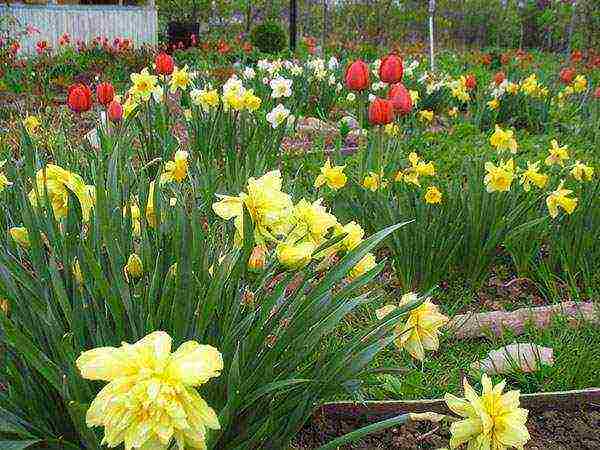 Not everyone knows, but there are many varieties of daffodils. Plants differ in the type of flower, the method of growing, the period and duration of flowering. Consider the most popular and most beautiful varieties of daffodils, their photos and the correct name.
Not everyone knows, but there are many varieties of daffodils. Plants differ in the type of flower, the method of growing, the period and duration of flowering. Consider the most popular and most beautiful varieties of daffodils, their photos and the correct name.
Poetic daffodil
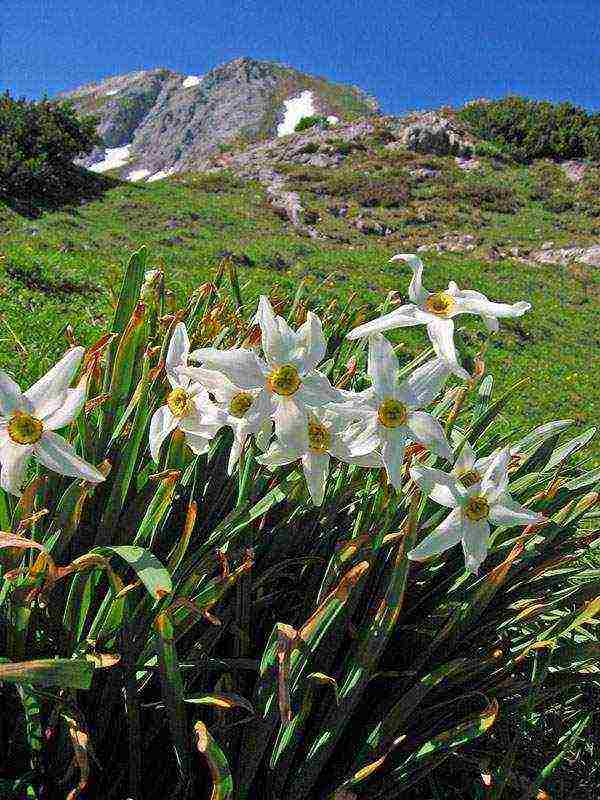 The flower was brought from the mountainous regions. In nature, the poetic daffodil lives on hills, near water bodies and springs. The species was originally bred near the Mediterranean Sea and not far from Italy. The plant grows rapidly and blooms among chestnut trees. For full development, the flower needs moderate moisture and direct sunlight. The flower grows up to 50 centimeters in height. Propagated by bulbs that are in the shape of a ball or chicken egg, with a pointed end. One bush of the poetic daffodil produces up to five flat, long leaves. They are bright green in color. Flowers bloom on a single branch, white, heads look down. Inside they have a crown of bright yellow color.
The flower was brought from the mountainous regions. In nature, the poetic daffodil lives on hills, near water bodies and springs. The species was originally bred near the Mediterranean Sea and not far from Italy. The plant grows rapidly and blooms among chestnut trees. For full development, the flower needs moderate moisture and direct sunlight. The flower grows up to 50 centimeters in height. Propagated by bulbs that are in the shape of a ball or chicken egg, with a pointed end. One bush of the poetic daffodil produces up to five flat, long leaves. They are bright green in color. Flowers bloom on a single branch, white, heads look down. Inside they have a crown of bright yellow color.
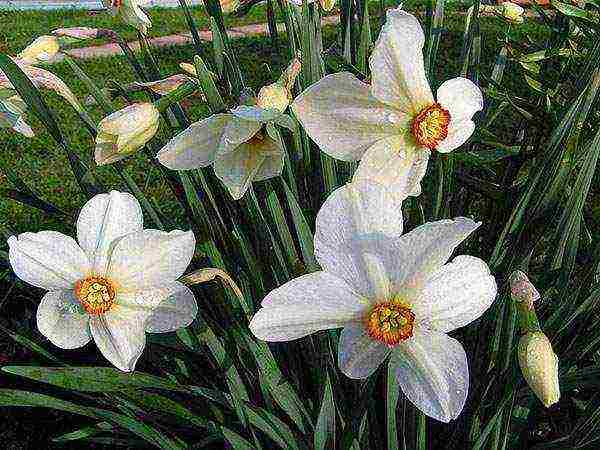 The species was first bred in 1538. The Italians liked the daffodil for its strong fragrance. The size of the blossoming flower reaches six centimeters. The flower-bearing stalk grows longer than the leaves and can reach fifty centimeters. The plant emerges from the ground in early spring, is actively growing and begins to bloom in the month of May. Flowering period up to 12 days.
The species was first bred in 1538. The Italians liked the daffodil for its strong fragrance. The size of the blossoming flower reaches six centimeters. The flower-bearing stalk grows longer than the leaves and can reach fifty centimeters. The plant emerges from the ground in early spring, is actively growing and begins to bloom in the month of May. Flowering period up to 12 days.
When the temperature drops below 10 degrees in winter, the flower requires shelter.
After reviewing the photo with the daffodil and the description of the variety, you can choose the plant you like of the poetic daffodil and breed it on your site.
Yellow daffodil
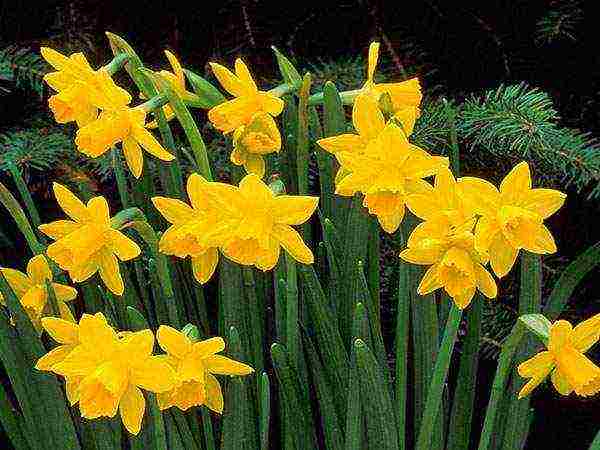 The representative of this variety has a second name - false daffodil. The flower was brought from France, Germany and southern Italy. Grows well on the slopes of the Caucasus Mountains. The yellow daffodil grows short. An adult plant reaches 30 centimeters. Propagated by bulbs, the diameter of which does not exceed 5 centimeters. They are round, less often oval. One flower blooms on a flower stem, which reaches a diameter of 4 cm. The flower, in the process of active growth, releases thin, dark green leaves, which are located 10 centimeters below the flower.
The representative of this variety has a second name - false daffodil. The flower was brought from France, Germany and southern Italy. Grows well on the slopes of the Caucasus Mountains. The yellow daffodil grows short. An adult plant reaches 30 centimeters. Propagated by bulbs, the diameter of which does not exceed 5 centimeters. They are round, less often oval. One flower blooms on a flower stem, which reaches a diameter of 4 cm. The flower, in the process of active growth, releases thin, dark green leaves, which are located 10 centimeters below the flower.
Inside the blossoming flower there is a crown, bright yellow in color with a corrugated uneven edge. The flowering period of the yellow daffodil begins in mid-May. It lasts no more than 15 days. The flower has been bred and introduced into garden culture since 1500.
Thanks to this variety, many forms of the plant have been bred by crossing.
Gardeners use yellow daffodil for ennobling near house plots and rocky gardens, planting them next to tulips, a royal crown, in mixed plantings and compositions with juniper.
White daffodil
 The flower was brought from the Iberian Islands. It grows well on mountain slopes enriched with picturesque vegetation, including abundant grass. White daffodil can be seen in acidified soil or pine forests. An adult flower reaches 35 centimeters. Propagated and planted with bulbs. They are no more than 4 cm in size and are spherical. The flower has thin, multiple green leaves. The flower-bearing stalk does not exceed 23 centimeters. The flower is white, like the inner crown.
The flower was brought from the Iberian Islands. It grows well on mountain slopes enriched with picturesque vegetation, including abundant grass. White daffodil can be seen in acidified soil or pine forests. An adult flower reaches 35 centimeters. Propagated and planted with bulbs. They are no more than 4 cm in size and are spherical. The flower has thin, multiple green leaves. The flower-bearing stalk does not exceed 23 centimeters. The flower is white, like the inner crown.
White daffodil has been introduced into culture since 1579. It begins to grow actively in mid-spring. By the end of May, the flower dissolves flowers, which are fragrant for no more than 10 days.
When grown in low temperatures, daffodils should be covered during the cold season.
Pink daffodil
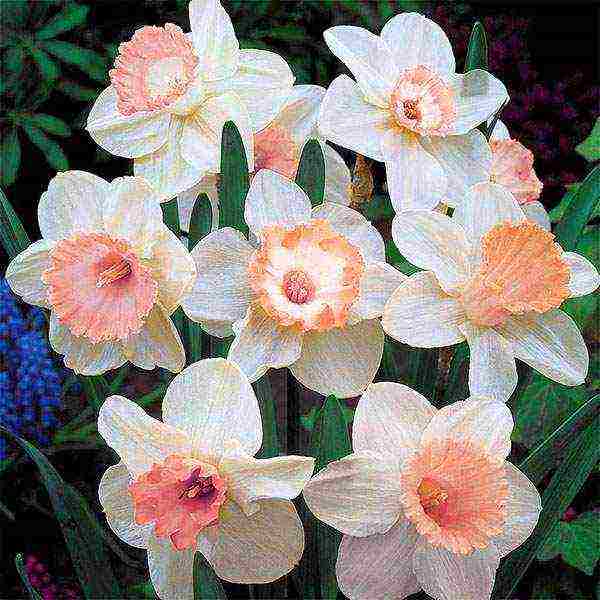 The flower was brought from western Italy in 1520. At about the same time, the variety was introduced to the culture in the south of France. Pink daffodil differs from other plant species in its rather high size. The flower reaches 45 centimeters. The leaves are dark green and wider than that of other species by 0.5 centimeters. Differs in the color of the flower itself. During the flowering period, 1 bud is located on the pedicel. The flower has a white color with a pale pink crown, quite unusual for this group of plants.
The flower was brought from western Italy in 1520. At about the same time, the variety was introduced to the culture in the south of France. Pink daffodil differs from other plant species in its rather high size. The flower reaches 45 centimeters. The leaves are dark green and wider than that of other species by 0.5 centimeters. Differs in the color of the flower itself. During the flowering period, 1 bud is located on the pedicel. The flower has a white color with a pale pink crown, quite unusual for this group of plants.
Pink daffodil propagates with the help of bulbs. In an adult plant, they can reach 5 centimeters. Daffodil blooms in early May. To preserve the flower, it is better to dig up the bulb for a period of rest and keep it in a dark place until the onset of spring. Pink daffodil can not only ennoble the garden plot, but also surprise the guests. The plant will draw attention to the flower bed in any design.
Narcissus Tete-a-Tete
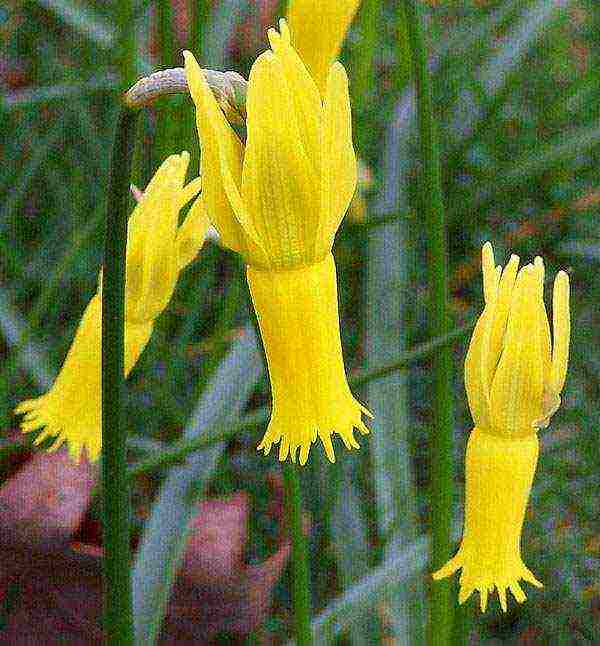 The flower belongs to the cyclamen group. Narcissus Tet-a-Tet has been cultivated since 1584. Brought from the mountains of the Caucasus and Germany. The plant reaches a short stature. Most often, the daffodil does not exceed 25 centimeters in height. One inflorescence is located on the peduncle. The bud has a drooping appearance, strongly lowered to the ground. The flower is bright yellow in color with unusual petals raised up.
The flower belongs to the cyclamen group. Narcissus Tet-a-Tet has been cultivated since 1584. Brought from the mountains of the Caucasus and Germany. The plant reaches a short stature. Most often, the daffodil does not exceed 25 centimeters in height. One inflorescence is located on the peduncle. The bud has a drooping appearance, strongly lowered to the ground. The flower is bright yellow in color with unusual petals raised up.
Narcissus Tet-a-Tet blooms from the beginning of May. Has a pleasant aroma. Drought intolerant. Plants are planted along curbs and low fences. It grows well and produces new globular bulbs. During wintering, the flower is dug up and stored in a dark, cool place until spring.
In ancient Rome, daffodils were considered flowers to symbolize victory. After the battle, the winner was hung a garland of this plant around his neck. Spectators brought live bouquets to some heroes of the fights.
Terry daffodils
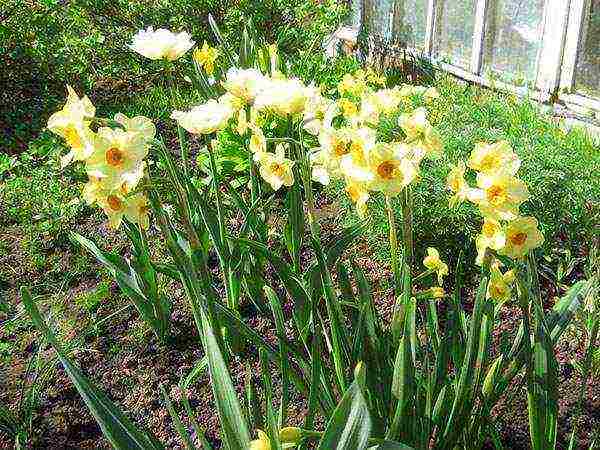 Most varieties of double daffodils are imported from South America. The plant loves a humid climate and does not tolerate prolonged drought. This group includes several types of daffodils, varieties with a photo, name and description are presented below.
Most varieties of double daffodils are imported from South America. The plant loves a humid climate and does not tolerate prolonged drought. This group includes several types of daffodils, varieties with a photo, name and description are presented below.
Gay Challenger
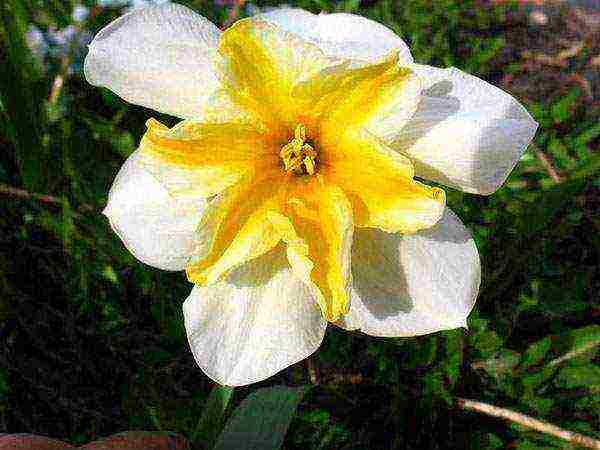 A low-growing plant with dark green leaves 0.5 centimeters wide. On each peduncle there is 1 flower of extraordinary beauty. During the flowering period, the double daffodil has a yellow flower with a bright orange crown, uneven in size. The bud size can exceed 7 centimeters. Flowers decorate bouquets, it has no equal when cutting. It begins to bloom at the end of May.
A low-growing plant with dark green leaves 0.5 centimeters wide. On each peduncle there is 1 flower of extraordinary beauty. During the flowering period, the double daffodil has a yellow flower with a bright orange crown, uneven in size. The bud size can exceed 7 centimeters. Flowers decorate bouquets, it has no equal when cutting. It begins to bloom at the end of May.
Variety Texas
 Belongs to the group of terry daffodils. The flower is large in size, has a double crown. The color is white - yellow or pale pink. Narcissus is unpretentious in cultivation.Loves rich and moist soil. Brought from Germany and Italy. The flower has been introduced into cultivation since 1565. Texas is great for group boarding. Suitable for decorating flower arrangements, may not fade for a long time without water when cut.
Belongs to the group of terry daffodils. The flower is large in size, has a double crown. The color is white - yellow or pale pink. Narcissus is unpretentious in cultivation.Loves rich and moist soil. Brought from Germany and Italy. The flower has been introduced into cultivation since 1565. Texas is great for group boarding. Suitable for decorating flower arrangements, may not fade for a long time without water when cut.
Terry daffodil of the Texas variety has an aromatic fragrance during the flowering period from mid-May. When wintering cold, it is better to cover.
Narcissus Ice King
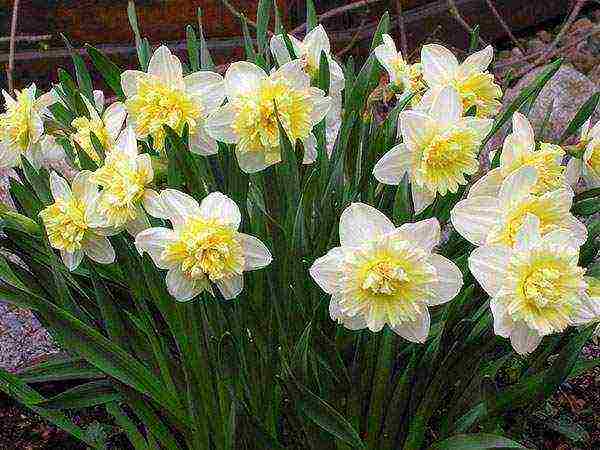 The plant was bred in Italy and has been planted by gardeners since 1850. Narcissus Ice King reproduces vegetatively. The bulb of an adult plant does not exceed 5 centimeters. What does a daffodil look like?
The plant was bred in Italy and has been planted by gardeners since 1850. Narcissus Ice King reproduces vegetatively. The bulb of an adult plant does not exceed 5 centimeters. What does a daffodil look like?
The photo shows the flower family. The plant has wide leaves located below and at the level of the bud. Each peduncle has one white flower with a light yellow crown. Narcissus Ice King is distinguished by its large flowers, the size of which reaches 11 centimeters.
Grows in abundantly moist soil. Does not tolerate prolonged drought.
Garden plots are ennobled with a flower, it is used in flower arrangements. Narcissus Ice King begins to bloom from the beginning of May. Will delight the gardener with beautiful flowers until the end of the month.
What does a Tahiti daffodil look like?
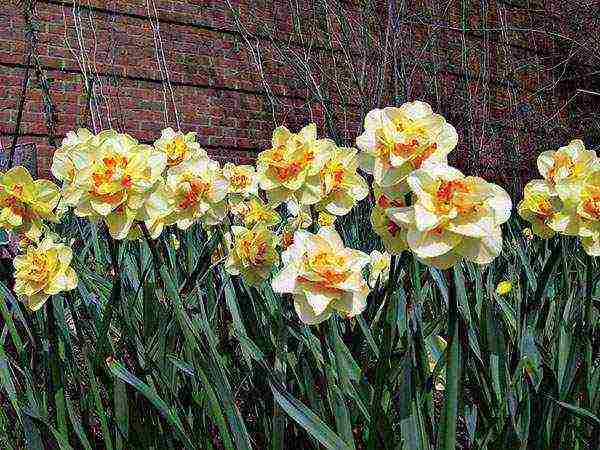 The plant has large double flowers reaching a size of 10 centimeters. The color of the main petals is light yellow. Inside there is a red - orange crown. Narcissus Tahiti grows up to 35 centimeters during the period of active growth. It has narrow dark green leaves that are located below the buds. Each flower has a separate peduncle.
The plant has large double flowers reaching a size of 10 centimeters. The color of the main petals is light yellow. Inside there is a red - orange crown. Narcissus Tahiti grows up to 35 centimeters during the period of active growth. It has narrow dark green leaves that are located below the buds. Each flower has a separate peduncle.
The plant reproduces vegetatively, grows in areas near the house. It tolerates direct sunlight well, loves moist soil. It grows well in groups. It has been actively growing since mid-May. By the end of flowering it fades, but does not lose its pleasant aroma.
Narcissus Replit
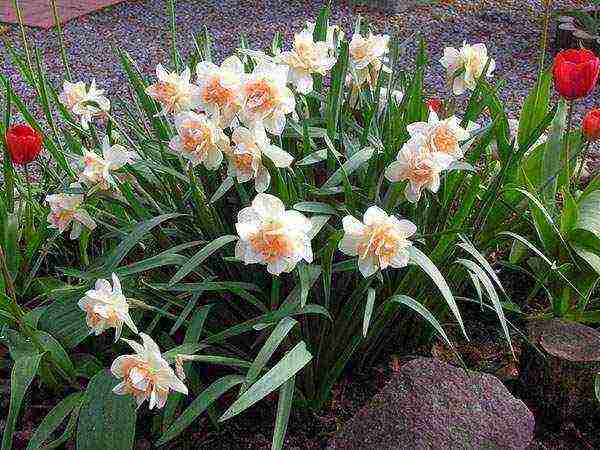 The plant reproduces vegetatively. It tolerates sunlight well and can grow in the shade of trees. The plant has wide leaves of a dark green color, located at the level and below the inflorescences. There can be several buds on one peduncle. The flowers are large in size with light pink petals. The crown is terry, with a peach tint. The plant reaches a height of 50 centimeters. Narcissus Replit is used for landscaping garden plots.
The plant reproduces vegetatively. It tolerates sunlight well and can grow in the shade of trees. The plant has wide leaves of a dark green color, located at the level and below the inflorescences. There can be several buds on one peduncle. The flowers are large in size with light pink petals. The crown is terry, with a peach tint. The plant reaches a height of 50 centimeters. Narcissus Replit is used for landscaping garden plots.
The flower loves richly enriched, moist and loose soil. Used in flower arrangements.
Narcissus Rip Vann Winkle
 The flower can be located and bloom, being in an open area and in the shade of trees. A low-growing plant, reaching a maximum length of 30 centimeters. It has wide leaves that do not grow to flowers. Narcissus Rip Van Winkle grows in moist and rich soil, does not tolerate drought. Flowers and crowns are double, bright yellow. Each peduncle has a single bud. The plant is dug up after flowering and planted in open ground at the end of winter.
The flower can be located and bloom, being in an open area and in the shade of trees. A low-growing plant, reaching a maximum length of 30 centimeters. It has wide leaves that do not grow to flowers. Narcissus Rip Van Winkle grows in moist and rich soil, does not tolerate drought. Flowers and crowns are double, bright yellow. Each peduncle has a single bud. The plant is dug up after flowering and planted in open ground at the end of winter.
Narcissus Obdam
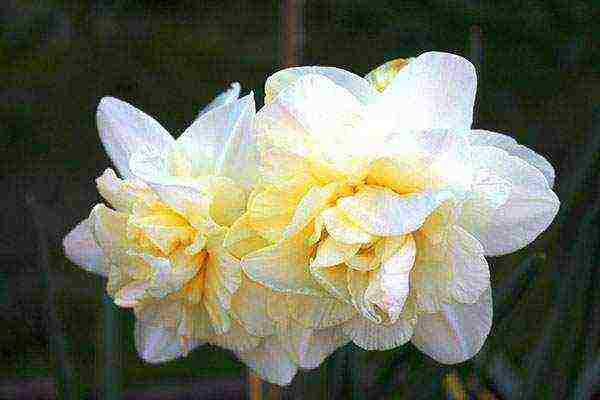 The plant belongs to the terry group. Narcissus Obdam is fragrant with a delicate and refined aroma. Flowers are located on a separate pedicel. They have a delicate beige shade. Large buds. When unfolded, they can exceed 10 centimeters. The plant grows large. At the end of active growth, it can exceed 50 centimeters.
The plant belongs to the terry group. Narcissus Obdam is fragrant with a delicate and refined aroma. Flowers are located on a separate pedicel. They have a delicate beige shade. Large buds. When unfolded, they can exceed 10 centimeters. The plant grows large. At the end of active growth, it can exceed 50 centimeters.
The bulbs are planted in fertilized soil at the end of summer. In early spring, the daffodil Obdam begins to sprout from the ground. In mid-May, the plant pleases others with its appearance. The flowering period lasts no more than 12 days. By the end of this period, the flowers fade to a white hue, but do not lose their delicate aroma. Gardeners are advised to plant tubers in open sunny areas or in the shade of trees.
The tubers of the plant are large enough, up to 6 centimeters. Narcissus Obdam is planted in garden plots in groups.
Interesting about the species and varieties of narcissus - video
I. Tubular daffodils. As already noted in the classification of daffodils, this group falls into three types.Therefore, here we will get acquainted with representatives of each type separately.
Yellow trumpet daffodils. A particularly interesting representative of this type is the daffodil Maximus (N. maximus). He deservedly enjoys fame and has been cultivated for a long time.
Large, brightly colored, yellow flowers of this daffodil on stems that reach a height of 75 centimeters or more attract attention even when planted next to new larger varieties. The flower tube at the base is dark green, above (to the base of the perianth segments) it becomes bright green. In the south, it blooms at the end of January, in more northern regions - later. Requires loose, nutritious and permeable soil, needs deep planting.
The daffodil Obvalaris (N. obvallaris, Hort) (Fig. 1), belonging to the same group and type, is also of great interest. This is a very characteristic short, early flowering form. Its distinctive feature is a wide-open tube and wide flat segments of the perianth. The color of the flowers is bright yellow. In gardens it succeeds worse than other forms, although in deep clay soils it grows well among grass. For culture under glass, it is quite suitable and can bloom in February.
Rice. 1. Variety of narcissus Obvalaris (N. obvallaris, Hort)
Among other representatives of yellow tubular daffodils, it should be noted that the varieties that are spreading in our country are Golden Spar, Henry Irving and King Alfred (Fig. 2).
Rice. 2. Variety of daffodil King Alfred
White tubular daffodils. Of the varieties belonging to this type, the most famous are Madame de Graaf, Mistress Krieledge and White Knight. The following varieties are very good for planting among shrubs and on lawns: 1) Milner, whose flowers are, strictly speaking, not white, but slightly creamy; 2) Peter Barr with very large white flowers; 3) Birshiba (Fig. 3), distinguished by an extremely large flower (up to 13 cm in diameter) and its brilliant whiteness; 4) Kantara with even larger flowers than Birshiba, a very beautiful form.
Rice. 3. Variety of narcissus Birshib
White tubular daffodils are especially good when cut and placed in wide vases, in which they should be placed along with blueberry branches, unblown red-leaved plum sprigs, or young hawthorn leaves and branches.
Bicolor tubular daffodils. Of this group, first of all, the so-called Pseudonarcissus should be noted (Fig. 4). It is widespread in the wild throughout Europe and is often found in eastern Transcaucasia, where it grows on the slopes of the mountains. Due to its undemanding nature, it is one of the best daffodils for naturalization on lawns and in rare parks. It reproduces well by self-sowing (if the seeds are ripe). Its slender stems are very characteristic. Flowers are yellow in color: pale perianth and darker at the tube (crown).
Rice. 4. Narcissus cultivar Pseudonarcissus
Noteworthy is the very fragrant (vanilla-scented) variety Spring Glory (Fig. 5), which is easy to drive out and is one of the best varieties for indoor potting.
Rice. 5. Variety of daffodil Spring glory
The well-known varieties Impress and Imperial should also be noted.
In terms of use (for planting in gardens and cutting), bicolor tubular daffodils can be divided into two groups: 1) with a dark yellow tube (for example, Impress), giving a sharp contrast in color with the perianth; 2) with a lemon-yellow tube that gives less contrast in color to a white or cream-colored perianth.
Recently, relatively few new varieties with dark yellow tubes have appeared. There are many more varieties with lemon yellow or pale yellow tubes. Of the latter, we note two varieties of remarkable beauty: 1) Mistress Mej - for late distillation, with beautifully ruffled tube edges in a soft primrose tone; 2) Glen Rose; with a remarkably beautiful color and shape of flowers; 3) _Ptolemy - the earliest, blooming in January, a variety with large (up to 10 cm in diameter) flowers.II.
II. Incomparabilis. In culture, there are a number of varieties belonging to this group. At the same time, some of the original varieties, valuable as vigorously growing plants, have survived to this day. These are, for example, Better and Eggs with yellow flowers in two shades: Eggs and Bacon, with gray-white segments and dark orange crowns. The variety Sir Watkiah is very famous, but later it is replaced by the Fortuna variety, which has very large flowers with a crown of bright orange color.
Fortuna is an early variety that is very valuable for cutting, blooms for a long time and retains its color well (unless it is exposed to unfavorable weather); plant height - 60 cm (Fig. 6).
Rice. 6. Daffodil variety Fortuna
The most prominent of the new varieties are Ives (Fig. 7), Eyrendel and Hevlokk.
Ives stands out among other varieties with the darkest brilliant yellow color of the flower. The crown is rounded, bowl-shaped, the flower stem is high; blooms early and holds well in cut. This is a great plant for the garden.
Rice. 7. Variety of daffodil Ives
Eyrendel has larger flowers than Ives (up to 10 cm in diameter), entirely yellow in color.
Hevlokk has even larger flowers (up to 12.0 cm in diameter). The crown is darker in color than the perianth; the outer segments are bent slightly downward, and the inner ones are upward, which gives the flower a beautiful shape.
All of these varieties are especially recommended for growing in gardens and for cutting.
Some of the most beautiful and always attracting attention are the yellow varieties with a red crown. Of these varieties, we note: Damson, Killigru and Chilios.
Damson has an admixture of red color in the crown, which harmonizes very well with the yellow perianth. This variety is especially beautiful in strong light. The perianth is pale yellow, later becoming almost white, with a blush at the base. A great flower for cutting.
Killigrew is one of the most vigorous varieties of this group (bush height - 55 cm). The perianth is sulfur-yellow, paler at the edges. The crown is bright orange. The color does not change even in open areas.
Chilios has a beautifully folded yellow perianth and a graceful vase-shaped crown, which, when fully blossomed under favorable conditions, turns dark red-orange. The growth is powerful, the height of the flower stem reaches 45 cm.
Of the varieties with a white or whitish perianth and a yellow or red crown, we note Gret Worley, Bodilly, Nyssa and Folly.
Gret Worley is one of the best varieties in this group. The flowers are very large, with a bright yellow broad crown giving a sharp contrast to the pure white perianth. A good garden plant, but flowers are not perfectly shaped and are not strong for cutting.
Bodilly is also one of the best varieties with a beautifully formed vase-shaped crown of pure yellow color and a creamy perianth of excellent shape. The stem is high.
Nissa has a number of major advantages: proportionality, structure and excellent flower shape; its bright yellow crown and tall stature make it especially valuable for gardens.
Folly, in color, shape and cut strength, is perhaps even more valuable than the previous variety. Perianth segments are pure white, peculiarly and beautifully curved. The crown is regular, beautifully shaped, with notches and wide, but not deep, lobes. The color of the crown is bright yellow, passing at the anterior end into a brilliant red "band", which occupies the upper third of the inner and outer surfaces. The color remains in open areas. The plant is tall (55 cm), blooming profusely. Late variety.
The Incomparabilis group has given a number of very terry shapes. Varieties that do not have excessive doubleness are beautiful in large groups among shrubs and herbaceous plants.All terry varieties are good for cutting; they remain in bloom for a long time and give a rich color combination when several varieties are placed in a vase with a wide neck. Of the double varieties, we mention the Apricot Phoenix, with a predominantly delicate sulfur color, and an apricot-yellow shade reminiscent of a tea rose at the base of the segments, darkening towards the center; Primrose Phoenix is a good, dark yellow variety, full of terry, with six circles of well-formed perianth segments; Plenipo with rounded, densely double flowers, with alternating light and dark yellow color; Silver rose, which has a beautifully shaped creamy white perianth and a creamy crown, and the center is filled with less well-formed petals of both colors; Mary Copland is one of the best terry varieties in this section (fig. 8).
Rice. 8. Daffodil variety Mary Copland
III Barry. One of the most famous original, but still the most common varieties in this section is the daffodil Barry (original form). This variety grows well among grass (on lawns) and in curbs, grows quickly and blooms even when its bushes grow old and become thick. The perianth is bright yellow at first, and then turns pale, especially in the center of each segment; at this time, its softened tones harmonize even better with the shiny red edge of the crown.
There are comparatively few varieties without red and orange crown coloration in Barry's group. One of the achievements in this group is the Edgwin variety. This is a "giant" among other representatives of the Barry group, the flower of which reaches up to 13.0 cm in diameter. Plant height 65 cm. Perianth - ideal shape, pale yellow "primrose" color; the crown is even paler.
Crowned varieties with a red edge are more numerous. The most interesting of this group are: Dainki and Brightling.
Dainka's flower resembles a butterfly; the petals are waxy, the flower is yellow with a green tint, and the calyx has a narrow red border.
Brightling is very beautiful, with a rounded yellow perianth and a yellow, lobed (folded) crown with a dark orange border.
Forms with a pale perianth moved forward when the varieties Albatross (very tall) and Siegell appeared. They are some of the best varieties for planting in stripes and for creating massive “cold” tone patches among herbaceous groups that bloom later.
Of the other varieties in this group, Anthony and Senrise are worth mentioning (fig. 9).
Anthony has a tall white flower with flat perianths; the crown is small, of an original shape with a beautiful salmon-pink color along the edges.
Senrise is well known for being one of the earliest varieties with a brightly colored crown. Its white perianth at the base has bright yellow "rays" extending from the yellow crown with a red edge; excellent for cutting, but should be protected from sunlight. Flowers that develop in rooms from half-open (at the time of cutting) buds are especially beautiful. It is not suitable for planting in gardens, as it quickly burns out and has brittle yellowish-green leaves that look like diseased, and the plant itself dies off in early May and at this time has an ugly brown-yellow color. Recently, Barry varieties have appeared with a pure white perianth and a dark red crown, for example, Hedes, Carminou, Red Bacon and others.
Rice. 9. Narcissus Variety Senrise
IV... Leedsie. Representatives of the Leeds group have an extraordinary richness of colors for daffodils and an excellent flower shape, and some varieties in color and flower structure even approach orchids. To this it must be added that in culture they are relatively unpretentious. One of the most interesting varieties for us is Tsarina; very tall (important for cutting), with flowers up to 13.0 cm in diameter with corrugated petals and a lemon-yellow crown.
V... Narcissus Triandrus hybrids. This group of narcissists is little known in our country, although it deserves a lot of attention. Hybrids of the daffodil Triandrus are very numerous, the best of which are: Viscountess Norscliffe, with white flowers; Venice, with white flowers; Down (fig. 10), an exceptional beauty variety; Silver Himes, with a perianth excellent in whiteness and shape and a lemon-yellow crown; Snow lily, etc.
Rice. 10. Variety of daffodil Down
VI... Daffodil hybrids Cyclamineus. Hybrids of the daffodil Cyclamineus are even less known than Leeds, and are not of particular interest to us at the present time.
Vii... Jonquilia. Plants of this group differ from other daffodils in dark green, rounded, semi-cylindrical leaves and flowers with a short crown.
The main type, the daffodil Jonquilia (Fig. 11), is widespread in southern Europe as a naturalized plant. Its leaves resemble an ordinary onion, about 23.0 cm long, slightly grooved on the upper side. A weak, rounded stem bears two to six dark yellow flowers with a cup-shaped crown with a strong pleasant scent. Two or three Jonquilia flowers can fill a large room with their scent. This is an old garden plant that can stay in one place for a number of years if it is somewhat protected and well lit by the sun. Jonquilias are extremely widespread in culture and are of great industrial importance. Several varieties of Jonquilia are known, but in general there are few of them, and they differ little from the main type.
Rice. 11. Variety of daffodil Jonquilia
Jonquilia has produced a number of very important hybrid forms, the dark, erect and narrow leaves of which are much more beautiful than the broad leaves of other groups. Their positive features are also high stems, bearing from 2 to 3 flowers, opening sequentially, and a beautiful structure of a wide and rounded perianth. In addition to these advantages, Jonquilia hybrids, when cut, remain fresh and fragrant for a longer time than others. Of the hybrid varieties, the following deserve special attention: Bettercap, Lenars, Frevitian, Hesla, Polmes, Penpol.
Bettercap is one of the most famous varieties. It is a beautiful plant with a single-flowered stem. The flowers are pure yellow, the perianth is 7.5 cm in diameter. The crown is equal in length to the segments. A very fragrant variety, valuable for cutting.
Lenars is one of the most vigorous varieties: it often has two flowers per stem. The crown is flat, brightly colored orange during full bloom.
Frevithian is paler in color than the previous one, with a perianth of longer, wavy segments. Strong growth (55 cm) and two-flowered stem make it a very valuable garden plant.
Hasla has larger and flatter flowers with a short, open and wavy crown of a single color at the edges; perianth - pale yellow.
Polmes is even larger and paler than Hesla. Stem up to 50 cm in height; flowers are solitary, yellow, very beautiful, up to 9 cm in diameter. The outer segments are wide and flat, while the inner ones, with inwardly concave margins, are beautifully narrowed at the base and protrude slightly forward; the crown is short with a gracefully ruffled margin.
Penpol is a very large variety with 2-3 flowers per stem. The perianth is flat, the crown is large, open, very bright yellow, darker in color than that of Polmes and Hesla. The perianth is ribbed in structure. The stem reaches 50 cm (up to the ovary). The color of the underside of the segments is darker than the inner surface, due to which this variety stands out noticeably as one of the dark ones.
VIII... Tacetta. Tacettes are best characterized as "bunch-colored" daffodils, since the number of flowers on the stem reaches 12 (more often, however, there are from 4 to 8).
Tacettes come in a wide variety of shapes, which can be classified into three groups: 1) bicolor - with white perianth and yellow or orange funnel; 2) forms in which both the perianth and the crown are white; 3) forms in which the perianth and crown are yellow.
Bicolor tacettes. This group consists of two sections: but) forms with an orange crown; b) forms with a pale yellow crown.
The first section also includes the main type, the daffodil Tazetta. This form is extremely widespread and has many varieties, differing from each other in the size and shape of the crown. Narcissus Tacetta grows well on cultivated soils and is easily propagated by division, even with normal plowing or digging the soil.
Of the individual varieties of this form, the Gloriosus variety should be noted. It is significantly improved over the wild form. It is one of the best early forcing varieties; blooms in December. Gloriosus has a wonderful scent reminiscent of lemon mixed with jasmine scent.
Of the other varieties, the Chinese variety known by the strange name of the Sacred Chinese Lily deserves mention. This variety grows very easily in water and is therefore suitable for growing in glasses. Huge, rough-looking bulbs with many tips and tines usually produce 5 to 10 flower stems. The flowers are white with an orange crown, very similar to the Gloriosus variety, with the same pleasant smell, but their perianth tube is longer and the crown is more regular in shape. Leaves up to 2.5 cm wide and up to 25 cm long. The topmost flower is usually another 10–12 cm higher. When cultured in water, the best results are obtained in vessels so deep that the roots are at least 10 cm to the bottom. Bulbs can be placed between stones (but do not lift), but the water should only cover the bulbs.
From the second section of two-tone tacettes (with a pale yellow crown), two varieties should be noted: Primo (Fig. 12) and Grand Monarc.
Primo is an old, early flowering variety with bushy heads of several flowers, usually appearing in February. The flower has a strong smell of jasmine: the perianth is white, the crown is pale lemon. It is sometimes cultivated in greenhouses for forcing tomatoes.
Rice. 12. Daffodil Primo
The Grand Monarch features a lemon-colored crown and very large, beautifully formed flowers. This variety is well driven, but blooms somewhat later than others. Of the tacettes with a lemon-yellow crown, Grand Monarc is the only variety that grows well and reliably in the soil.
White tacettes. A typical representative of this group is the daffodil Papiraceus, the most vigorous variety that reproduces well outdoors (Fig. 13).
Rice. 13. Variety of daffodil Papiraceus
Among other representatives, we note the daffodil Broussoneti and Papiraceus grandiflorus, otherwise called Paper White (Fig. 14).
Rice. 14. Narcissus Variety Paper White
Broussoneti in general appearance belongs to the group of tacettes with white flowers, but differs sharply from other representatives of this group by the rudimentary development or even the complete absence of a crown and prominent stamens. It is a relatively gentle plant, rarely successful in Europe, but very interesting.
Papiraceus grandiflorus is the largest variety in this group. This is a very old garden plant, with a large number of bulbs used for forcing for cutting. It is driven out so early and easily that it can bloom as early as December and is therefore the first daffodil to replace chrysanthemums. Its flower shape is star-shaped and the perianth segments are longer than the crown than in most other forms of tacettes. Perianth segments are pure white, slightly transparent and loose in structure compared to the dense structure and dull tones of all yellow-crowned tacettes. Has an "extra" scent, which, however, lacks a refreshing lemon scent. Its industrial significance is very high.
Yellow tacettes. Of this group, the Italian narcissus and Soleil d'or are of the greatest interest (Fig. 15).
Rice. 15. Daffodil variety Soleil d'or
The Italian daffodil essentially has a white perianth, but the presence of a yellow tinge in this white coloration and a lemon-yellow crown make it a member of this group. This variety is often self-propagated. Its growth is strong, but in more northern regions it usually blooms too late and rarely. Even in favorable locations near the sea, it has fewer flowers than in southern France, where flowers reach up to 5 cm in diameter.
Soleil d'or was one of the most brilliant yellow varieties with an orange, almost scarlet crown before the Fortuna variety. In terms of growth vigor, size, early flowering and color, it is considered one of the best tacettes. It has been known in culture since the first half of the 18th century and was widespread in our country.
Hybrid tacettes. Most of the hybrid varieties of this group originated from the crossing of tacetta with poetic narcissus (Fig. 16), and some of them arose naturally (for example, Biflorus), and some were obtained artificially (for example, Batselman, Capri and others). Many of these varieties, along with tacettes, are considered to be very valuable bouquet-flowering daffodils for pot culture and for distillation. They fall into two groups: with a white perianth
and with yellow. The most outstanding varieties are: Alsas, Aspazia, Elvira, Agnessa, Medusa and a number of others.
Rice. 16.Variety of narcissus poetic
IX... Narcissus is poetic. This species includes 9 independent subspecies, which are divided into two groups. The first group includes 5 species with the following common features: the stamens are uneven, the perianth segments are shortly narrowed and overlap tiled from below, the crown is flat. The second group unites 4 species with the following common features: the stamens are almost even, the perianth segments at the bottom are usually narrowed. For horticultural purposes, these forms can be subdivided into early ones, of which the Ornatus variety is best known (Fig. 17) and the later ones, like Recurvus (Fig. 18).
Ornatus is an early flowering variety that is well driven and grows freely in the open field in the beds or in the herbage.
Rice. 17. Narcissus Variety Ornatus
Recurvus (pheasant eyes) is strong growth, late flowering and very graceful. The extraordinary whiteness of its strong, curved segments and the remarkable coloration of the greenish-yellow crown with a crimson border ensure a perfect end to the daffodil flowering period. Its smell, with an admixture of nutmeg aroma, is too strong, especially if many flowers are placed in a small room.
Rice. 18. Narcissus cultivar Recurvus
Among the varieties of this group, mention should be made of Sarhedon, Tiddlewinks and Estrella (Fig. 19).
The poetic narcissus has long had double forms, for example, Poeticus plenus, Gardenia narcissus and others, which, under favorable conditions, are excellent plants, but they are not successful everywhere. For successful growth, they need rich, deep soil and a relatively even climate; if during their development there are sharp changes in temperature, for example, there are cold nights or, conversely, dry hot days, the buds often do not develop. Still, in many areas, terry varieties are very valuable plants, blooming at the end of May, when other varieties have already faded.
Rice. 19. Narcissus Estrella cultivar
X... Other (wild) daffodils. Practically from this group, we may be interested only in autumn species, which bloom, unlike all others, in late autumn, as well as a species that is very valuable for us - the daffodil Bulbokodium (Fig. 20).
Rice. 20. Variety of daffodil Bulbokodium
The most famous of this group are two species: the daffodil Viridiflorus (Fig. 21) and the daffodil Serotinus (Fig. 22). The first blooms in November, the second in December. These species would be an excellent addition to the selection of winter, early spring and late spring daffodils and could fill the most dull seasons with their flowering.They also work very well under glass cultivation, if certain requirements are met (mainly with respect to complete maturation of the bulbs and the composition of the soil in pots). The livelihood of these species begins with the fall of autumn rains after a rest period caused by the usual summer drought and heat.
Rice. 21.Daffodil variety Viridiflorus
In daffodil Viridiflorus, the stem and leaf are bright green, rounded, like onions. Strong bulbs produce leaves up to 25 cm long; in damp places, the leaves are usually twice as wide as in plants from dry areas. Bulbs in damp places are close to the surface, but normally they are located at a depth of 10-15 cm and in hard clay soil they are difficult to dig out. Bulbs that are deeply embedded in the soil are spherical, but in culture they lengthen, taper and become similar to the bulbs of one- or two-year-old seedlings of various varieties of daffodils.
Rice. 22. Daffodil variety Serotinus
The flowering bulb has two integumentary leaves, but the inner one is only an underdeveloped leaf with a tubular base, sometimes bearing a small projection; thus, the number of onion scales produced annually is limited to only two. The same is observed in non-flowering bulbs, which do not form a stem, and only the bases of the integumentary and true leaves give the scales of the bulb; the latter are unusually thick and fleshy.
The stalk, pedicel, ovary and the wrong side of the segments appear dull-bluish in color. At magnification, it can be seen that the bluish color is due to dots scattered over the dark green surface of the leaf; on the inner side of the perianth segments, these white dots are more irregular in shape, coarser and "mealy". The green color of the perianth and crown is a feature of this species.
Although this wonderful daffodil is small in size and relatively difficult to educate, it is so interesting and has such a pleasant smell that it must be introduced into the culture. In some years, it grows strongly and blooms beautifully, but when kept under glass in a cool room, it does not always go well and in some years does not produce leaves or stems; the next year, after transplanting in August, it usually produces strong and healthy growth. Good results were obtained by planting the bulbs in pots and hanging them under glass in a greenhouse so that the bulbs dry out thoroughly and mature during the resting period.
Daffodil Serotinus is the most common of the autumn species. It is a small plant that grows in hot, dry places; it is rather difficult to cultivate. The flowers of the daffodil Serotinus are brilliant white with a bright orange tinge of small lobes of the crown. The scent is strong and very pleasant, reminiscent of jasmine.
In conclusion, let us dwell on an extremely characteristic, sharply different from other daffodils and very valuable for us species, namely the daffodil Bulbokodium. This species is found in two forms: with white flowers and with yellow flowers.
White Bulbokodium grows on stony soils, among small shrubs, in the shade; the yellow one prefers open places and grows almost always on rocks, on flat ledges, forming turf, while the white form grows singly or 2-3 together.
For open field crops, the white Bulbokodium is very valuable for potting. At an early age, its pure white flowers have a brilliant hue; later the color fades, but still remains beautiful. For practical purposes, the yellow form is conveniently divided into pale lemon yellow and dark yellow.
The pale lemon-yellow form is often found in damp soils, where it produces larger flowers than other forms. In general, the whole plant is extremely original and graceful. Height reaches 15–20 cm. It succeeds well on damp soils, but it goes even better in cool, mossy places in forests and on grassy damp slopes, where this form reproduces by self-seeding. One of the best dark yellow garden forms is known as the Conspicus.Her leaves are beautiful, upright, the tube and the wrong side of the segments have green spots.
Today in the world there are up to 30 thousand varieties of narcissus... All of them, according to the existing classification, are divided into 13 groups, 12 of which are bred by breeders, and one represents natural species. This allows you to systematize plants by the shape, size and color of flowers, their number on the peduncle, by height.
Previously, the flowers were white or yellow, modern daffodils amaze with all kinds of combinations of shades of white, cream, yellow, pink. In many varieties, the color tone changes during flowering. The leaves are narrow, long, green with a bluish tinge.
The minimum knowledge of the classification of daffodils is needed in order to choose a variety not only according to external data, but also taking into account how the plant will be used - for bouquets, winter flowering indoors, decorating the garden, where it will be planted when it blooms, whether it will survive in our conditions. If you choose the right varieties, then the flowering of daffodils can be enjoyed from late April to early June.
Some types of daffodils, especially jonquils, contain valuable essential oils. They are specially grown in Algeria, France, Italy, China, Holland, using the highest class perfume as a component.
Group 1. TUBULAR (Trumpet).
The tube (crown) of a flower is of the same length with petals or slightly longer, similar to a gramophone tube. The top of a tall and strong peduncle is crowned with a single flower 6-8 cm in diameter. Petals are yellow or linen, tubes are yellow, orange, red, linen. Ideal for bouquets, suitable for winter bloom, garden decoration. They grow well in our conditions.
The most famous varieties: Albert Schweitzer, Ballada, Beersheba, Hans Christian Andersen, Gold Medal, Golden Harvist, Dutch Master, Easter Bonnet, Little Jam, Lunar Sea, Mount Hood, Music Hall, Priamble, Point Barrow, Celebrity.
Group 2. Large-cupped.
The largest group, universal application. On the peduncle there is one flower with a crown, the height of which is more than a third of the length of the petals. The flowers are large, 8-12 cm. The petals are yellow, orange, white. The color of the crown is white, pink, yellow, orange, red, with a green eye in the center. The edge of the crown can be wavy, corrugated.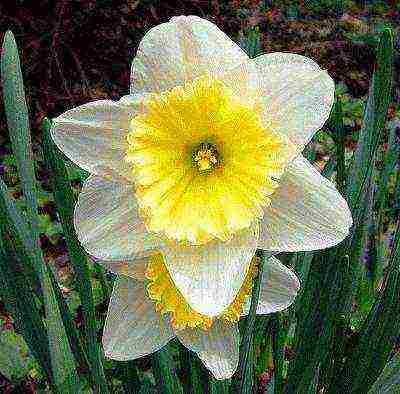
Varieties: Ice Fallis, Daydrim, Carlton, Curley, Mount Tekoma, Mercato, Modern Art, Orange Progress, Precaucus, Professor Einstein, Royal Orange, Rococo, Salome, Sound, Selma Lagerlef, Semiramis, Smaragd, Tibordet, Flower Plant.
Group 3. Small-cupped).
On a high, strong peduncle, one large flower with a diameter of 6-8 cm, the crown is low, up to a third of the length of the petals. They grow well, live long. As a rule, they have a delicate aroma, their use is universal. Many new varieties of very different colors have been bred. The crown is often bordered, white, in various shades of pink, yellow, red-orange.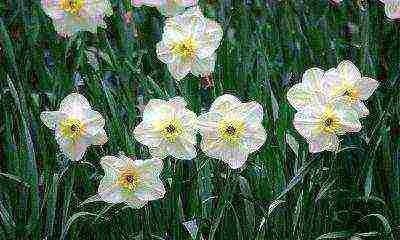
Varieties: Altruist, Amor, Audubon, Barrett Browning, Burma, Verga, Verona, Limerick, Matapan, Flaming Jewel, Chinez White, Epricot Distinction.
Group 4. Terry (Double).
Terry can be either one crown or the whole flower. The petals are traditionally white, yellow, orange. The crown is white, pink, yellow, orange and even red. Flowers of various sizes and colors, single or collected in a brush. Great for bouquets. A significant disadvantage of terry varieties is that they lose their appearance after heavy rains, droop and often break.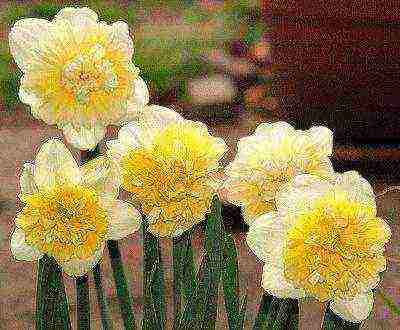
The best varieties of terry daffodils: Irene Copeland, Ice King, Acropolis, Van Zion, Golden Ducket, Double Fashion, Delnasho, Dick Wilden, Dorchester, Yellow Chirfulnes, Inglescombe, Indian Chief, Modern Art, Manley, Mary Copeland, Obdam, Petit Replit, Rip van Winkle, Tahiti, Texas, White Lyon, Flower Drift, Chirfulness, Exotic Beauty.
Group 5. TRIANDRUS (Triandrus).
Flowers are small, hanging, 2-6 on a low stem. The petals are slightly pulled back, the crown is small, in the form of a glass. The color of the flowers is white, yellow, golden.Plants are graceful, miniature, suitable for planting among stones. In the middle lane, they are not widespread due to their weak winter hardiness.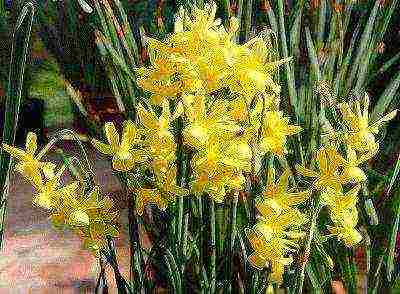
There are few varieties: Ice Wings, Liberty Bells, Stoke, Thalia, Tresembl, Havera.
Group 6. Cyclamineus (Cyclamineus).
On a low peduncle, 1-2 drooping flowers, small and graceful. The crown is in the form of a narrow long tube, the petals are strongly bent back. Used for curbs, rocky hills design.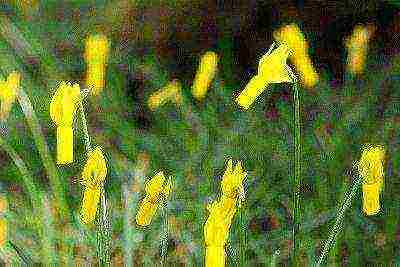
Varieties: Andalusia, Beryl, Baby Dole, Garden Princesses, Jack Snipe, Jenny, Jetfire, Piping Tom, Tete-a-tete, Februerie Gold, Februerie Silver.
Group 7. Jonquilla
They resemble triandrus, but there are more flowers on one stem, 5-7 pieces, they are larger, often fragrant, with small, bowl-like crowns and elongated petals. Many varieties are short, have a delicately fragile appearance, are good for a rocky garden, tall ones are suitable for a mixborder. The leaves are very narrow, like grass.
Most varieties are quite thermophilic, in our conditions they do not live long, but in the south of the country they feel good and are grown without transplanting for up to 7 years.
Varieties: Baby Moon, Belle Zong, Golden Chain, Pipit, Sweetness, Step Forward, Susie, Trevithien, Hesla, Hill-Star, Cherie.
Group 8. TACETTES (TACETTA, Tazetta), OR MULTI-FLORAL.
On a strong peduncle up to 35 cm high, dense clusters of 2-8 medium-sized fragrant flowers. The crowns are small, much shorter than the petals. The color of the petals is white, yellow, cream, the crown can be orange. The leaves are wide. They are appreciated for their winter bloom. The temperate climate is poorly tolerated; shelter for the winter is mandatory.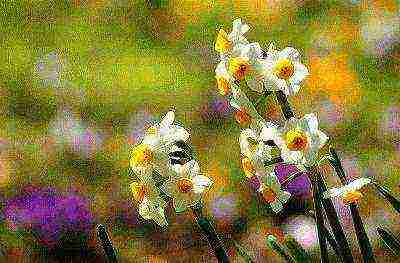
The best varieties: Geranium, Laurent Coster, Medusa, Minnow, Scarlet Jam, Orange Wonder, Silver Chaims, Elvira.
Group 9. POETIC (Poeticus).
One of the oldest garden daffodils in the world. Graceful fragrant white flowers on tall, light stems, the crown is short, yellow with a bright red border along the edge. Resistant to adverse conditions, can grow in partial shade. Suitable for long-term cultivation in one place. Very good for bouquet and winter bloom.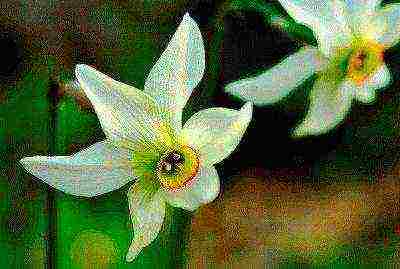
The best varieties: Actea, Queen of Narcissi, Margaret Mitchell, Milan, Red Rome, Sarchedon.
Group 10. Hybrids of narcissus BULBOCODIUM (BRANDUSHKA-NARCISSUS, Bulbocodium).
A new group currently under development in Australia. Single flower 3-5 cm in size on a low peduncle. Differs in original appearance, for which it is nicknamed "daffodil-crinoline": the tube is wide open and resembles a bell or a funnel, the petals are sharp and very small. There are forms of yellow and white color. Suitable for winter bloom on the window. In our conditions, it blooms only in the first year after planting, in severe winters it can freeze out.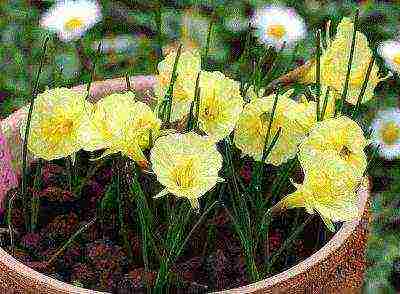
Group 11. Split-corona.
Exceptionally beautiful and diverse varieties with a strongly dissected crown (Split crown), which gives them an exotic look. They seem to have a second row of petals, the flowers may resemble a butterfly, orchid. On a high peduncle, one flower, reaching 10-12 cm. The use is universal. Decorative qualities may decrease after harsh winters, but recover after warm winters. It is recommended to plant in well-lit places, be sure to insulate for the winter.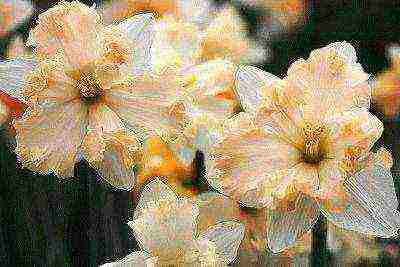
The best varieties: Articol, Baccarat, Broadway Star, Gold Collar, Dolly Mollinger, Canasta, Cassata, King Size, Colorrange, Congress, La Argentina, Lemon Beauty, Modesto, Mole Hobby, Mondragon, Orangerie, Palmares, Papillon Blanche, Parisienne, Pink Vander, Printl, Riesling, Sunny Side Up, Split, Taurus, Trepolo, Tricolet, Chanterel.
Group 12. OTHER NARCISSES (Miscellaneous).
This includes varieties and species that for some reason were not included in any of the groups, hybrids between representatives of different groups and plants of unknown kinship.
Group 13. SPECIES NARCISSES (Species). Includes wild species, forms and their hybrids.


